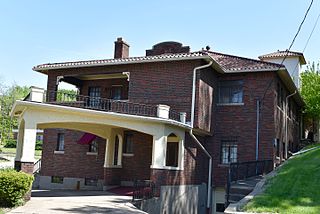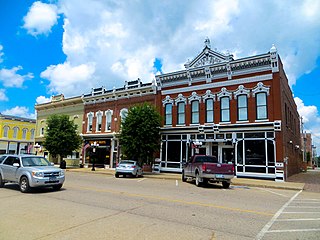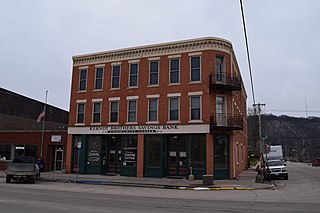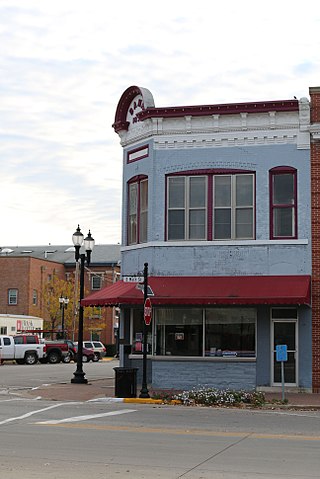
The Metropolitan Opera House (MOH) is a historic opera house in Iowa Falls, Iowa, United States. It was individually listed on the National Register of Historic Places in 1975. In 2012 it was included as a contributing property in the Washington Avenue Commercial Historic District.

The Princess Sweet Shop is a historic building located in Iowa Falls, Iowa, United States. It is noted as "an outstanding example of Art Deco design from 1935. The Carrara Glass façade, and streamlined woodwork are typical of Art Deco design of the 1920s and 1930s, but a rarity in a small town in Iowa." Ernie Karrys(Karamitsanis) and Nicholas P. Pergakis opened the Princess in 1915. Two years later, The Sweet Shop opened by Harry Pergakis. These three men were born in the town of Asprokampos, Greece. It was common for Greek immigrants to establish candy shop around the U.S. They combined their operations at the Princess location in 1928. Sadly, Nicholas died of cancer in September 1928 at age 39.<relative of N. Pergakis> The building was destroyed in a fire on December 25, 1934. Local architect L.L. Klippel designed the new building, which was completed in 1935. It was the first building in Iowa Falls that was air conditioned. Members of the Harry Perkagis family maintained ownership until 1987. The business is still in operation as a soda fountain under different ownership.

The W.R.C. Hall is a historic building located in Iowa Falls, Iowa, United States. Built in 1898, the building has segmented arched windows and a bracketed metal cornice, which are features of the Italianate style.

Jay Funeral Home, now known as the Robertson-Jay Funeral Home, is an historic building and funeral home located in Ottumwa, Iowa, United States. Local architect Archie Eaton designed the building in the Mediterranean Revival style. The two-story brick structure was completed in 1929. The exterior of the building features round arch windows, a tile roof, and a broad brick porte cochere. The building is noteworthy for its architecture and as an early example of funeral home design. It was individually listed on the National Register of Historic Places in 1995. In 1998 it was included as a contributing property in the Fifth Street Bluff Historic District.

The Benson Building, also known as the Union Bus Depot, was an historic building located in downtown Ottumwa, Iowa, United States. The Tudor Revival style commercial building was completed in 1930. The one-story structure was composed of highly textured, painted brick. The façade featured a steeply-pitched gable roof and half-timbering. The building was originally used as an indoor miniature golf course. Its significance was attributed to its architecture. It was individually listed on the National Register of Historic Places in 1995 as a part of the Ottumwa MPS. In 2016 it was included as a contributing property in the Greater Second Street Historic District.

The Oskaloosa Fire Station is a historic building located in Oskaloosa, Iowa, United States. It was designed by Des Moines architect Frank E. Wetherell, an Oskaloosa native, in the Renaissance Revival style. It was originally designed along with the adjoining city hall in 1905. The buildings were designed for phased construction, and the city council decided to build the fire station first. Completed in 1908, it is a three-story brick building with a 4½-story bell tower. The fire station was individually listed on the National Register of Historic Places in 1991. Previously it had been included as a contributing property in the Oskaloosa City Square Commercial Historic District.

The Public Square Historic District in Sigourney, Iowa, United States is a 11.9-acre (4.8 ha) historic district that was listed on the National Register of Historic Places in 1999. The listing included 41 contributing buildings, a contributing structure, and two contributing objects. The district includes work by architects Wetherell & Gage.

The Albia Square and Central Commercial Historic District encompasses most of the central business district of Albia, Iowa, United States. It was listed on the National Register of Historic Places (NRHP) in 1985. At the time of its nomination the district consisted of 92 resources, including 65 contributing buildings and 27 non-contributing buildings.

The Bonaparte Historic Riverfront District is a nationally recognized historic district located in Bonaparte, Iowa, United States. It was listed on the National Register of Historic Places in 1989. At the time of its nomination it contained 38 resources, which included 24 contributing buildings, one contributing structure, 11 non-contributing buildings, and two non-contributing structures. Three mill-related buildings near the Des Moines River are associated with the Meek's family who had a central role in the town's development from its founding through the turn of the 20th-century. They include the woolen mill (1863), the flour mill (1878), which is individually listed on the National Register, and the pants factory (1892). Eighteen commercial buildings are of brick construction. Of those, eight are two-story structures, and ten are single-story structures. The remaining three buildings are wood frame commercial buildings. The single historic structure is the stone lock in the city park, which is also individually listed on the National Register.

The Cundill Block is a historic building located in Maquoketa, Iowa, United States. Local photographer Will Cundill had this two-story brick commercial building constructed in 1882. His studio was originally located on the second floor before he moved it to the main floor in 1895 when he built an addition onto the back. A variety of retail businesses have occupied the commercial space over the years. The building is representative of the brick commercial buildings that were built in Maquoketa in the 1880s and the 1890s. It features simple brick hoodmolds over the windows and a brick patterned cornice across the top. Although covered, the iron storefront remains in place. The building was listed on the National Register of Historic Places in 1991.

Hotel Charitone is a historic building located in Chariton, Iowa, United States. Local architect William L. Perkins designed the building in the Neoclassical style. It was his second major commission in town after the Chariton Herald-Patriot Building (1918). Local contractor P.E. Johnson constructed the building. It opened on November 5, 1923, and remained in operation as a hotel with some apartments under various owners. The buildings had fallen into disrepair and was vacant when Hy-Vee, a grocery store chain that had been headquartered in Chariton for years spearheaded the renovation of the building as an act of gratitude for the community's support.

G. Kerndt & Brothers Office Block, also known as the Kerndt Brothers Building, is a historic building located in Lansing, Iowa, United States. The four Kerndt brothers were all German immigrants who settled in the Lansing area by 1854. Gustav, William and Mortiz established a broom factory and cigar business in town while Herman farmed and provided the broom corn for the factory. In 1861 they built the first part of this building to house their general store. They were so successful they expanded the building in 1866. In addition to the store they also owned a gran elevator along the Mississippi River. Added to this they started in private banking as a part of their mercantile business. In 1908 it was incorporated by the family as the Kerndt Brothers Savings Bank. This building now houses the Kerndt Brothers Savings Bank Community Center.
Grand Avenue Historic Commercial District is a nationally recognized historic district located in Spencer, Iowa, United States. It was listed on the National Register of Historic Places in 2004. At the time of its nomination the district consisted of 57 resources, including 39 contributing buildings, and 18 noncontributing buildings. The district cover's most of the city's central business district, mainly along Grand Avenue, but on some of the intersecting streets as well. In addition to commercial buildings, the district also includes the post office, a theater, and a fraternal lodge. The commercial Romanesque Revival and Neoclassical styles are dominant. The period of significance begins in 1913 when a building boom of more "modern" construction began and ends in 1935. A fire started by fireworks destroyed nearly two full blocks, and affected 70 businesses and professional offices. The architects who designed the new buildings went for a unified approach utilizing a Spanish/Mission influence. The Iowa Legislature passed a law banning the sale of fireworks throughout the state.

The Sentinel Block is a historic building located in Iowa Falls, Iowa, United States. Previous commercial blocks in Iowa Falls tended to follow the more ornate Italianate style. This building, completed in 1905, marks a departure from those older structures. Rectilinear brick panels above the windows replaced the decorative hoodmolds, and the brick patterned cornice with a plain stone cap replaced the heavy metal cornice. The building also features an oriel window with a crenelated parapet. The building housed the Iowa Falls Sentinel for over 20 years. It began as the Eldora Sentinel in 1857, relocated to Iowa Falls in 1865, and was bought out by its competitor, the Hardin County Citizen, in 1927.

The Ellsworth–Jones Building is a historic building located in Iowa Falls, Iowa, United States. Eugene S. Ellsworth was a land broker, town developer, and philanthropist. This building was the headquarters of his firm Ellsworth and Jones, who sold land throughout Iowa and other states in the Midwest. While Iowa Falls was their headquarters, they also had offices in Chicago, Boston, and Crookston, Minnesota. The three-story, brick Neoclassical building was completed in 1902. It features Ionic and Doric columns, egg-and-dart motif on the lower level columns, round arches, acanthus leaf keystones, foliated decorative elements, a dentils on the cornice.

The Washington Avenue Commercial Historic District is a nationally recognized historic district located in Iowa Falls, Iowa, United States. It was listed on the National Register of Historic Places in 2012. At the time of its nomination the district consisted of 59 resources, including 42 contributing buildings and 15 non-contributing buildings. The district takes in most of the city's central business district. The buildings here were generally used for retail and office purposes. An opera house and theater are also located here. Around the edges of the district are buildings that housed automobile dealerships. The buildings generally range from one to two stories, but a couple structures are three stories in height. Built between 1857 and 1960, the buildings are composed of masonry construction. The commercial Italianate and Classical Revival styles are dominant.

The McClanahan Block is a historic building located in Iowa Falls, Iowa, United States. The city experienced a devastating fire in 1874, and most of the buildings on this block were built after the fire giving them a commonality of design. This two-story commercial building, completed in 1913, stands out given its polychrome brick and the simplicity of its design. Its decorative elements are found in the patterns created on its surface utilizing the bricks. At the time this building was constructed, Washington Avenue was paved and cement sidewalks replaced their wooden predecessors.

First National Bank is a historic building located in Mount Pleasant, Iowa, United States. The bank was first located on this corner in the 1860s. Its first building was a small, brick Italianate structure. This building replaced it in 1923. It is a two-story stone structure designed by Chicago architect Paul V. Hyland in the Neoclassical style. It is unique in Mount Pleasant in that it is the only stone building facing the square, and it reflects more of a public building instead of a commercial building. It is similar in style to the Henry County Courthouse, which is diagonally across the square. The exterior of the primary and secondary facades is composed of ashlar limestone and features paired pilasters on the corners of the primary facade, and a single column in the Corinthian order that flank the main entrance. It is capped with a simple classical cornice and parapet roof. The alley side of the building is composed of red brick. The building was listed on the National Register of Historic Places in 1991.

Henry County Savings Bank is a historic building located in Mount Pleasant, Iowa, United States. Because this two story, brick Italianate structure was built specifically as a bank, it features a chamfered corner, which was commonly used to designate a bank in the last quarter of the 19th century. Other features typical of an Italianate commercial building include segmental arched windows, a corbeled brick frieze, and a bracketed metal cornice. The building was listed on the National Register of Historic Places in 1991.

National State Bank is a historic building located in Mount Pleasant, Iowa, United States. Because this two story, brick Italianate structure was built specifically as a bank, it features a chamfered corner, which was commonly used to designate a bank in the last quarter of the 19th century. However, it combines other features typical of an Italianate commercial building in an unusual way. The secondary facade has segmental arched windows that are regularly spaced, while the primary facade has the windows in a sophisticated arrangement that one would expect of an architect-designed building. The metal cornice has widely spaced brackets on the primary facade and more typically spaced on the secondary facade. It also lacks an identification pediment on the corner, which is typical of the style. The building was listed on the National Register of Historic Places in 1991.






















